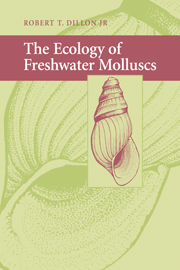1 - Introduction
Published online by Cambridge University Press: 11 August 2009
Summary
The invasion launched by elements of the molluscan army upon fresh water has aptly been characterized as ‘desultory’ (Deaton and Greenberg 1991). Dozens of offensives seem to have taken place, sporadically timed over hundreds of millions of years, some ultimately carrying the works, others now witnessed only in the fossil record. The diversity of fresh-water molluscs is vast. Yet it is my thesis here that in their interactions with the environment and with each other, freshwater molluscs share enough similarities that some intellectual profit may be gained by examining their ecology together.
We might begin with a brief overview of the forces (Tables 1.1 and 1.2). The larger freshwater bivalves belong to the order Unionoidea, an ancient group of six families whose fossil record extends to the Devonian period. They are distinguished by a parasitic larval stage that is unique among the Bivalvia. The best-known families are the Margaritiferidae and the highly diverse Unionidae, both worldwide. The hyriids of Neotropical and Australian regions are less studied, while the Neotropical mycetopodids, and the Ethiopian mutelids and etheriids, remain rather obscure.
The smaller infaunal freshwater bivalves belong to the superfamily Corbiculoidea. This is a somewhat younger group, generally hermaphroditic, with a fossil record beginning in the Jurassic and Cretaceous periods. The two corbiculoid families may represent separate invasions of fresh water (Park and O'Foighil 1998). Bivalves of the worldwide family pisidiidae hold developing embryos for extended periods, ultimately releasing juveniles quite large in relation to their own bodies.
- Type
- Chapter
- Information
- The Ecology of Freshwater Molluscs , pp. 1 - 7Publisher: Cambridge University PressPrint publication year: 2000
- 1
- Cited by



